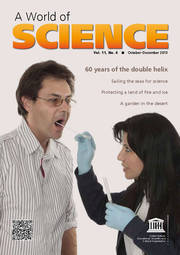Vol 3 N° 1 [January–March 2005]
CONTENTS
IN FOCUS
p 2 - Physics without tears
NEWS
p 8 - Reform of Nigeria’s science system gets under way
p 8 - A Decade to educate
p 10 - Water Co-operation Facility launched
p 10 - Nineteen new biosphere reserves
p 11 - IPSO determined 'to make peace happen'
p 12 - A half-century for CERN
p 13 - Trieste Science Prize to celebrate science from South
p 13 -A second UNESCO–Cousteau Chair for the USA
INTERVIEW
p 14 - Herwig Schopper on Einstein's legacy
HORIZONS
p 17 - The silent world revisited
p 20 - Our closest relatives on the brink of extinction
IN BRIEF
p 24 - Governing bodies
p 24 - Diary
p 24 - New releases
Quick link to Vol. 3 n° 1 (PDF document);
See also ARCHIVES for A World of Science
EDITORIAL
Why physics? Why now?
One hundred years ago, a young man working in the Patent Office in Bern, Switzerland, published a series of scientific articles. These introduced revolutionary ideas on fundamental questions related to the existence of atoms, the nature of light, the concepts of time and space, energy and matter. They opened up a whole new world composed of the infinitely small (particles), the infinitely large (the cosmos) and the infinitely complex (the states of matter). The name of this young man was Albert Einstein and his theories would lay the foundations for transistors, computers, lasers, televisions, magnetic resonance imagery in medicine and space travel.
Ambassador Moleko of Lesotho evoked this Miraculous Year, as it is known, when presenting a resolution for an International Year of Physics in 2005 to the United Nations six months ago.
The International Year of Physics celebrates the genius of Albert Einstein. But the Year is as much forward-looking as commemorative. If anything, we have an even greater need of the physical sciences now than ever before. How else will we solve the major problems of the 21st century related to energy production, environmental protection and public health? But first, we will need to persuade dubitative politicians that the technologies they will need tomorrow are the basic research of today.
More than 60 countries around the world are preparing special events to celebrate the Year, of which UNESCO is lead agency and one of the co-ordinators within an international steering committee led by the European Physical Society.
The Year is being launched by a conference on the theme of Physics for Tomorrow from 13 to 15 January at UNESCO Headquarters. Open to the general public, the conference will focus on the role of physics in society and its impact on everyday life, the influence of Einstein on the science of the 20th and 21st centuries, the teaching of physics and its links with other disciplines.
Given the troubling – and in some cases growing – disaffection for physics among the younger generation, the lead story in this issue looks at how teaching methods are evolving towards activity-based tuition, a promising new approach.
A World Conference on Physics and Sustainable Development in Durban from 31 October to 2 November will round off the Year, sponsored primarily by UNESCO and its Abdus Salam International Center for Theoretical Physics, the South African Institute of Physics and the International Union of Pure and Applied Physics. Approximately 500 physicists and policy-makers from around the world will meet to discuss the ties between physics and economic development, health, energy, environment and education. The conference is expected to come up with an agenda for action that the international physics community can implement collectively.
W. Erdelen
Assistant Director-General for Natural Sciences

